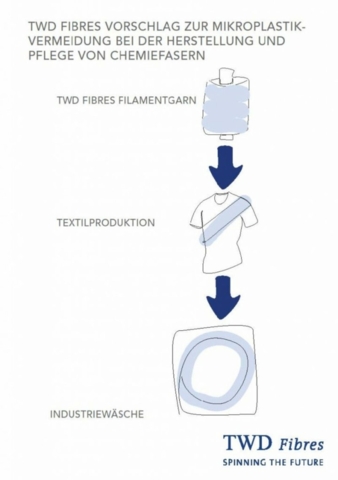11/04/2019 – Techtextil: TWD Fibres — auf Deutsch lesen
To avoiding microplastics!
TWD Fibres' policy is to minimize microplastics in the production of filament yarns in an effort to protect our environment.
Microplastics are a threat to our environment and are often mentioned in connection with marine pollution.
In addition to the plastics contained in cosmetics and many other sources, microplastics are also a concern of the textile industry, although the share of microplastics used in this industry is frequently overestimated. TWD Fibres GmbH believes in taking responsibility for our Planet Earth and in preserving a livable habitat for future generations. That is why TWD Fibres GmbH, in a concerted effort to protect our environment, has made it a company policy to minimize the emission of microplastics.
According to the Joint Research Centre (JRC) of the European Commission, plastic particles with sizes smaller than five millimeter are referred to as microplastics. One of the ways microplastics typically get into the environment is e.g. in the form of peeling particles contained in cosmetics. Once these particles enter the oceans, marine organisms will often confuse them with food and ingest them. This is how microplastics enter the ecological cycle, and they have even been detected in food. A distinction is made between primary microplastics, i.e., particles produced in that particular size, and secondary microplastics resulting from the decomposition of plastic products. (Source: https://www.lgl.bayern.de/lebensmittel/chemie/kontaminanten/mikroplastik/)
At TWD Fibres GmbH, plastic granulate is spun into polyester and polyamide 6.6 yarns, textured, and dyed or finished as required
Varying amounts of microplastics are indeed produced during the various work steps. However, TWD Fibres GmbH is making a special effort to protect our environment by having installed e.g. an in-house system for waste water treatment.
To prevent plastic particles from escaping into the environment, all waste water from TWD’s yarn production and in-house dyeing plant is carefully treated in an in-house biological treatment plant
March 14, 2019 Free copy, specimen copy requested involving several purification steps. With the help of bacteria, the addition of oxygen and a precipitating agent, the wastewater is thoroughly cleaned while plastic particles are carefully filtered out of the water. This means that after purification, virtually all microplastics contained in the wastewater end up in the sewage sludge.
Microplastics are released not only during the production of textiles, but also during the washing of finished textile products such as clothing and bed linens.
As part of a study on the “Development of measures to increase the value retention of leasing textiles” conducted by the Hohenstein Institute for Textile Innovation, various textiles were investigated with regard to fiber abrasion. As part of the study, filament yarn made by TWD Fibres GmbH, amongst others, was compared with staple fiber yarns made by other manufacturers. The investigations were focusing in particular on workwear and protective clothing. Using textiles made of 100 percent cotton, 100 percent polyester and blended fabrics (50 percent cotton, 50 percent polyester), various washing trials including pre-wash, main wash and rinse cycles were carried out. The trials were conducted with varying parameters like temperature, time, detergent, and mechanics.
The trials showed that yarns made by TWD Fibres GmbH, which are exclusively filament yarns, have important advantages over the staple fiber yarns used for comparison purposes. In addition, it was concluded that industrial laundering has significant advantages over private laundering, due to an additional downstream filtering process. The proportion of microplastics remaining in the waste water after industrial washing was found to be virtually negligible.
To analyze the waste water, a new method using dynamic image analysis was developed as part of the study in order to determine and distinguish the particles.
According to the Hohensteiner Institute, dynamic image analysis provides significantly more information on the nature of wastewater contamination than is otherwise possible with conventional filter methods.
Ways for microplastics avoidance in the manufacture and care of textiles in industry, commerce, and private households
In the best-case scenario, yarns produced in Germany – ideally filament yarns – are used for textile products made from man-made fibres, such as e.g. the products made by TWD Fibres GmbH. The legal regulations governing waste water recycling are much stricter here than, for example, in many Asian production countries. This is generally a good argument for textile production in Germany. To avoid polluting the environment with potential fiber abrasion during washing, professional industrial laundering is an excellent solution as its additional filtration steps will significantly reduce the waste water's existing microfiber load. As a general rule, all wastewater in Germany is treated - i.e., all wastewater both from the industry and from private households. As a result, all microplastics particles contained in the waste water are filtered out nearly one hundred per cent, which is a huge step towards protecting our environment.
TWD Fibres at the Techtextil
Hall 4.2 stand D 02




